HONDA ACCORD SEDAN 2001 Owner's Manual (in English)
Manufacturer: HONDA, Model Year: 2001, Model line: ACCORD SEDAN, Model: HONDA ACCORD SEDAN 2001Pages: 372, PDF Size: 6.1 MB
Page 331 of 372
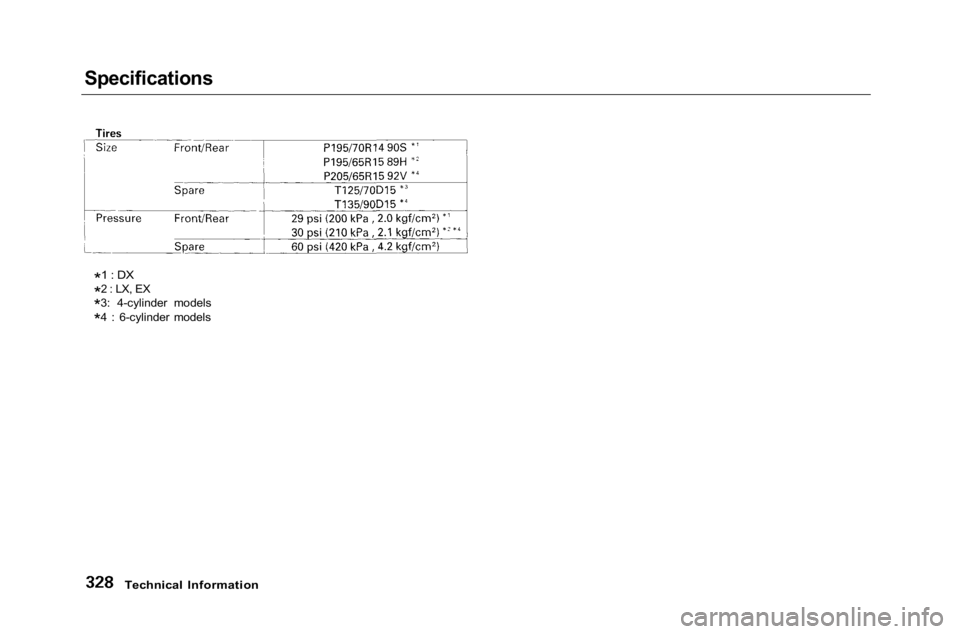
Specifications*1 : DX
*2 : LX, EX
*3: 4-cylinder models
*4 : 6-cylinder models
Technical Information
Page 332 of 372
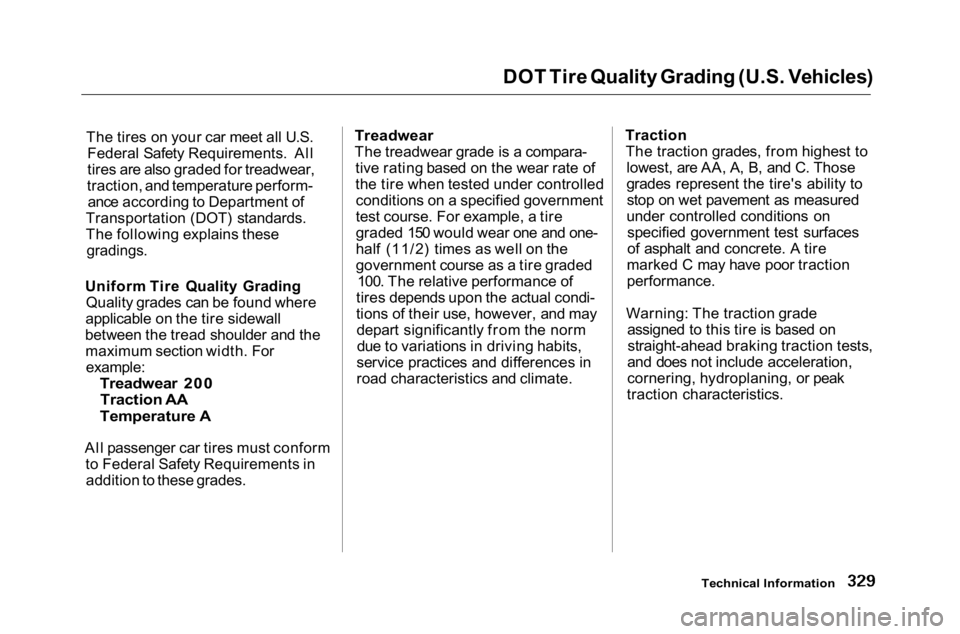
DOT Tire Quality Grading (U.S. Vehicles)
The tires on your car meet all U.S. Federal Safety Requirements. All
tires are also graded for treadwear,
traction, and temperature perform- ance according to Department of
Transportation (DOT) standards.
The following explains these
gradings.
Uniform Tire Quality Grading Quality grades can be found where
applicable on the tire sidewall
between the tread shoulder and the maximum section width. For
example:
Treadwear 200Traction AA
Temperature A
All passenger car tires must conform to Federal Safety Requirements inaddition to these grades.
Treadwear
The treadwear grade is a compara-
tive rating based on the wear rate of
the tire when tested under controlledconditions on a specified government
test course. For example, a tire
graded 150 would wear one and one-
half (11/2) times as well on the
government course as a tire graded 100. The relative performance of
tires depends upon the actual condi-
tions of their use, however, and may depart significantly from the normdue to variations in driving habits,
service practices and differences in
road characteristics and climate. Traction
The traction grades, from highest to lowest, are AA, A, B, and C. Those
grades represent the tire's ability tostop on wet pavement as measured
under controlled conditions on specified government test surfaces
of asphalt and concrete. A tire
marked C may have poor traction
performance.
Warning: The traction grade assigned to this tire is based onstraight-ahead braking traction tests,
and does not include acceleration,
cornering, hydroplaning, or peak
traction characteristics.
Technical Information
Page 333 of 372
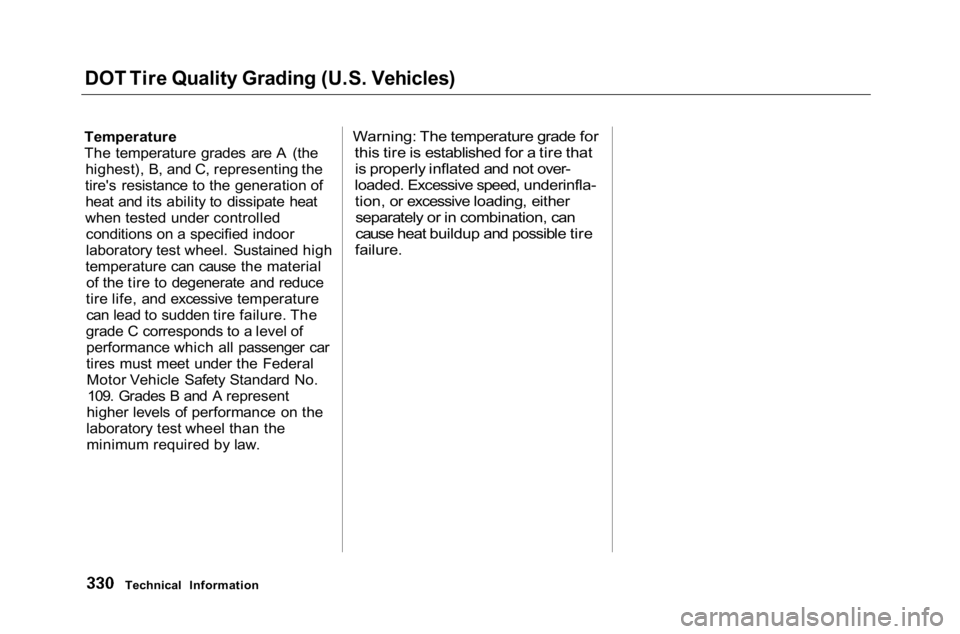
DOT Tire Quality Grading (U.S. Vehicles)
Temperature
The temperature grades are A (the highest), B, and C, representing the
tire's resistance to the generation of heat and its ability to dissipate heat
when tested under controlled conditions on a specified indoor
laboratory test wheel. Sustained high
temperature can cause the material of the tire to degenerate and reduce
tire life, and excessive temperature can lead to sudden tire failure. The
grade C corresponds to a level of performance which all passenger car
tires must meet under the FederalMotor Vehicle Safety Standard No. 109. Grades B and A represent
higher levels of performance on the
laboratory test wheel than the minimum required by law.
Warning: The temperature grade for
this tire is established for a tire that
is properly inflated and not over-
loaded. Excessive speed, underinfla-
tion, or excessive loading, either
separately or in combination, can
cause heat buildup and possible tire
failure.
Technical Information
Page 334 of 372

Oxygenated Fuels
Some conventional gasolines are
being blended with alcohol or an
ether compound. These gasolines
are collectively referred to as
oxygenated fuels. To meet clean air
standards, some areas of the United
States and Canada use oxygenated
fuels to help reduce emissions.
If you use an oxygenated fuel, be
sure it is unleaded and meets the
minimum octane rating requirement.
Before using an oxygenated fuel, try
to confirm the fuel's contents. Some
states/provinces require this
information to be posted on the
pump.
The following are the U.S. EPA and
Canadian CGSB approved
percentages of oxygenates:
ETHANOL (ethyl or grain alcohol)
You may use gasoline containing up to 10 percent ethanol by volume.Gasoline containing ethanol may be
marketed under the name "Gasohol."
MTBE (Methyl Tertiary Butyl
Ether)
You may use gasoline containing up
to 15 percent MTBE by volume.
METHANOL (methyl or wood
alcohol)
Your vehicle was not designed to use fuel that contains methanol.Methanol can corrode metal parts in
the fuel system, and also damage
plastic and rubber components. This damage would not be covered by
your warranties. If you notice any undesirable
operating symptoms, try another
service station or switch to another
brand of gasoline.
Fuel system damage or performance
problems resulting from the use ofan oxygenated fuel containing more
than the percentages of oxygenates
given above are not covered under
warranty.
Technical Information
Page 335 of 372
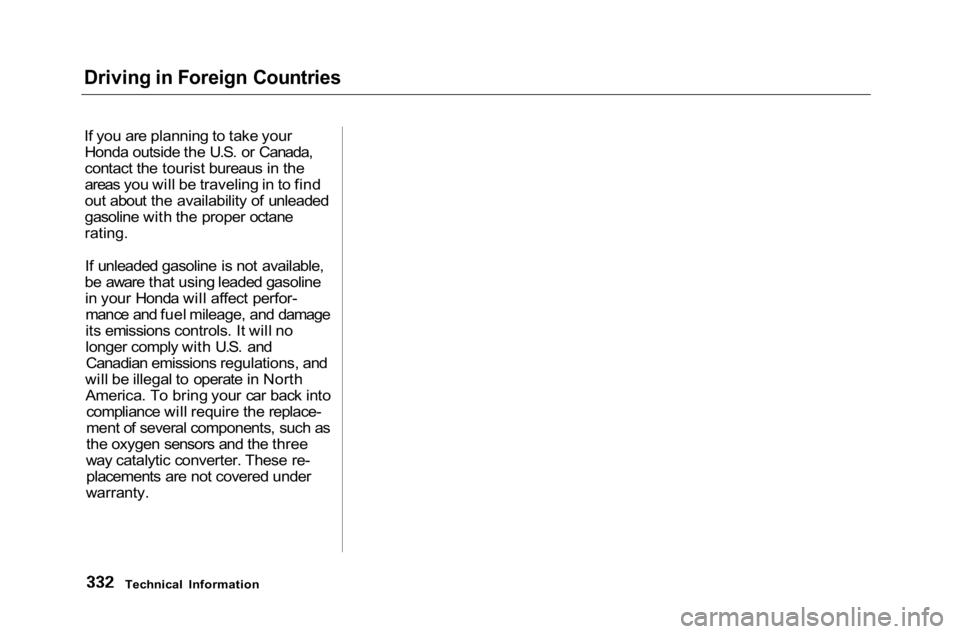
Driving in Foreign Countries
If you are planning to take yourHonda outside the U.S. or Canada,
contact the tourist bureaus in the
areas you will be traveling in to find
out about the availability of unleaded
gasoline with the proper octane
rating.
If unleaded gasoline is not available,
be aware that using leaded gasoline in your Honda will affect perfor-mance and fuel mileage, and damage
its emissions controls. It will no
longer comply with U.S. andCanadian emissions regulations, and
will be illegal to operate in North America. To bring your car back into compliance will require the replace-
ment of several components, such as
the oxygen sensors and the three
way catalytic converter. These re- placements are not covered under
warranty.
Technical Information
Page 336 of 372
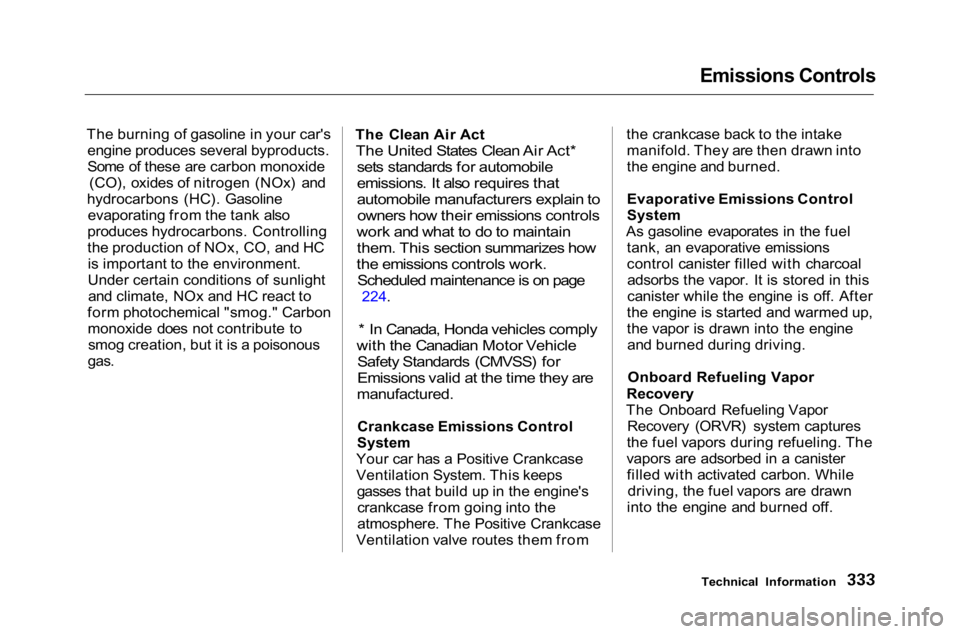
Emissions Controls
The burning of gasoline in your car's engine produces several byproducts.
Some of these are carbon monoxide (CO), oxides of nitrogen (NOx) and
hydrocarbons (HC). Gasoline evaporating from the tank also
produces hydrocarbons. Controlling
the production of NOx, CO, and HC is important to the environment.
Under certain conditions of sunlightand climate, NOx and HC react to
form photochemical "smog." Carbon monoxide does not contribute tosmog creation, but it is a poisonous
gas.
The Clean Air Act
The United States Clean Air Act*
sets standards for automobile
emissions. It also requires that
automobile manufacturers explain to
owners how their emissions controls
work and what to do to maintain
them. This section summarizes how
the emissions controls work.
Scheduled maintenance is on page
224.
* In Canada, Honda vehicles comply
with the Canadian Motor Vehicle
Safety Standards (CMVSS) for
Emissions valid at the time they are
manufactured.
Crankcase Emissions Control
System
Your car has a Positive Crankcase
Ventilation System. This keeps gasses that build up in the engine'scrankcase from going into the
atmosphere. The Positive Crankcase
Ventilation valve routes them from the crankcase back to the intake
manifold. They are then drawn into
the engine and burned.
Evaporative Emissions Control
System
As gasoline evaporates in the fuel tank, an evaporative emissions
control canister filled with charcoaladsorbs the vapor. It is stored in this
canister while the engine is off. After
the engine is started and warmed up,
the vapor is drawn into the engine and burned during driving.
Onboard Refueling Vapor
Recovery
The Onboard Refueling Vapor Recovery (ORVR) system captures
the fuel vapors during refueling. The
vapors are adsorbed in a canister filled with activated carbon. While driving, the fuel vapors are drawn
into the engine and burned off.
Technical Information
Page 337 of 372
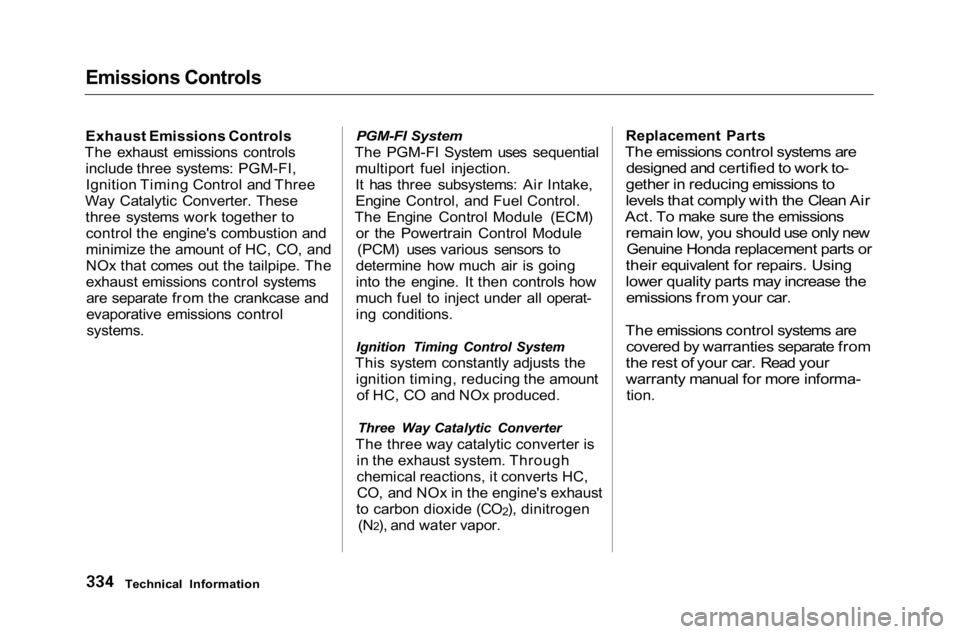
Emissions Controls
Exhaust Emissions Controls
The exhaust emissions controls include three systems: PGM-FI,Ignition Timing Control and Three
Way Catalytic Converter. These three systems work together tocontrol the engine's combustion and
minimize the amount of HC, CO, and
NOx that comes out the tailpipe. The
exhaust emissions control systemsare separate from the crankcase and
evaporative emissions control
systems.
PGM-FI System
The PGM-FI System uses sequential multiport fuel injection.
It has three subsystems: Air Intake,
Engine Control, and Fuel Control.
The Engine Control Module (ECM) or the Powertrain Control Module (PCM) uses various sensors to
determine how much air is going
into the engine. It then controls how
much fuel to inject under all operat-
ing conditions.
Ignition Timing Control System
This system constantly adjusts the ignition timing, reducing the amountof HC, CO and NOx produced.
Three Way Catalytic Converter
The three way catalytic converter is in the exhaust system. Through
chemical reactions, it converts HC,CO, and NOx in the engine's exhaust
to carbon dioxide (CO 2), dinitrogen
(N2), and water vapor. Replacement Parts
The emissions control systems are
designed and certified to work to-
gether in reducing emissions to
levels that comply with the Clean Air
Act. To make sure the emissions
remain low, you should use only newGenuine Honda replacement parts or
their equivalent for repairs. Using
lower quality parts may increase the emissions from your car.
The emissions control systems are
covered by warranties separate from
the rest of your car. Read your
warranty manual for more informa-
tion.
Technical Information
Page 338 of 372
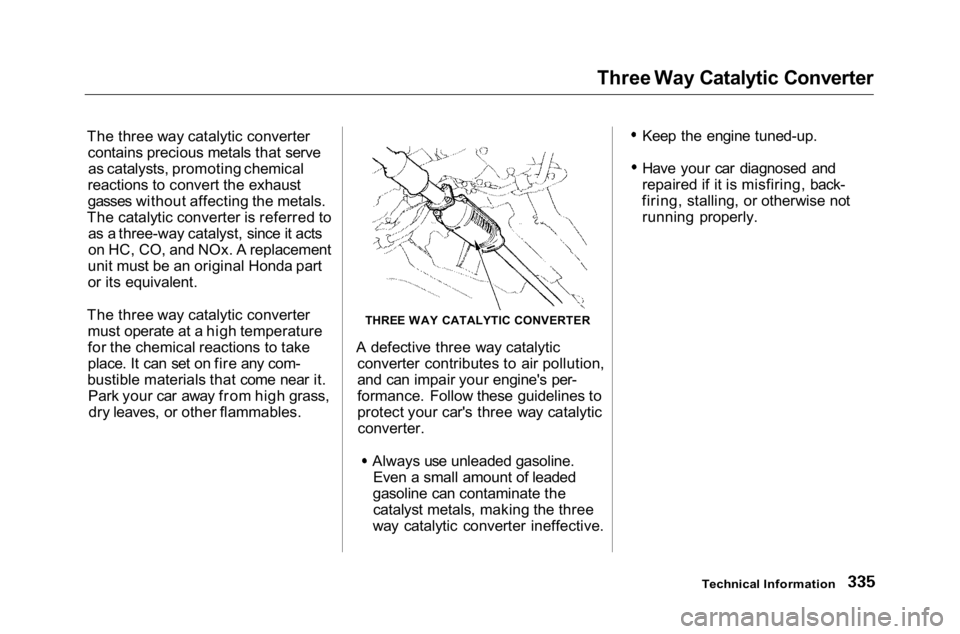
Three Way Catalytic Converter
The three way catalytic converter contains precious metals that serveas catalysts, promoting chemical
reactions to convert the exhaust
gasses without affecting the metals.
The catalytic converter is referred to as a three-way catalyst, since it acts
on HC, CO, and NOx. A replacement
unit must be an original Honda part
or its equivalent.
The three way catalytic converter must operate at a high temperature
for the chemical reactions to take
place. It can set on fire any com-
bustible materials that come near it. Park your car away from high grass,dry leaves, or other flammables. A defective three way catalytic
converter contributes to air pollution,
and can impair your engine's per-
formance. Follow these guidelines to
protect your car's three way catalyticconverter.
Always use unleaded gasoline.Even a small amount of leaded
gasoline can contaminate the catalyst metals, making the three
way catalytic converter ineffective. Keep the engine tuned-up.
Have your car diagnosed and
repaired if it is misfiring, back-
firing, stalling, or otherwise not running properly.
Technical Information
THREE WAY CATALYTIC CONVERTER
Page 339 of 372
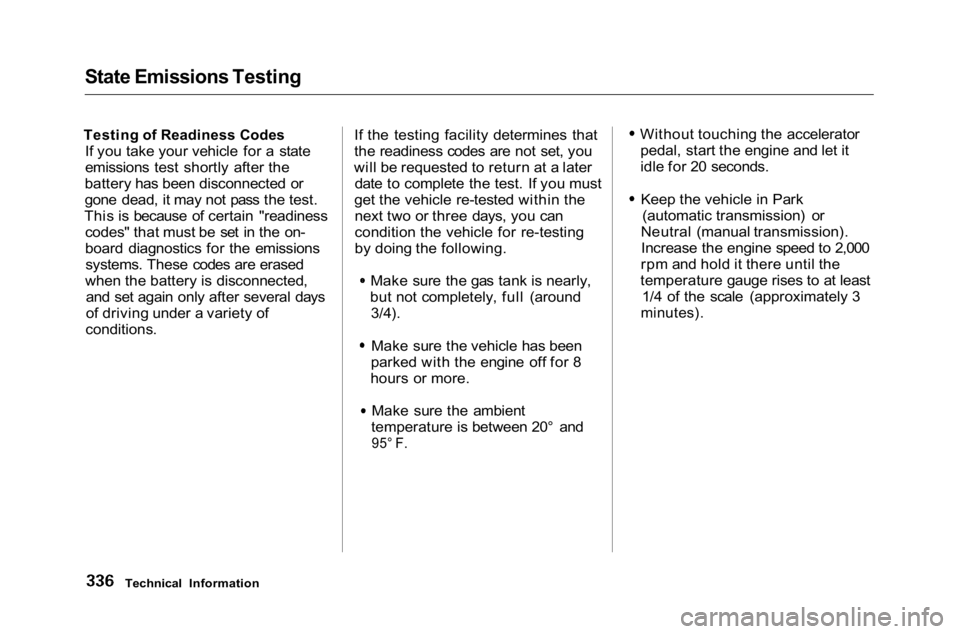
State Emissions Testing
Testing of Readiness Codes
If you take your vehicle for a state
emissions test shortly after the
battery has been disconnected or
gone dead, it may not pass the test.
This is because of certain "readiness codes" that must be set in the on-
board diagnostics for the emissionssystems. These codes are erased
when the battery is disconnected, and set again only after several days
of driving under a variety of
conditions. If the testing facility determines that
the readiness codes are not set, you
will be requested to return at a later date to complete the test. If you must
get the vehicle re-tested within the next two or three days, you can
condition the vehicle for re-testing
by doing the following.
Make sure the gas tank is nearly,
but not completely, full (around 3/4).
Make sure the vehicle has been
parked with the engine off for 8
hours or more.
Make sure the ambient
temperature is between 20° and
95°
F.
Without touching the accelerator
pedal, start the engine and let it
idle for 20 seconds.
Keep the vehicle in Park (automatic transmission) or
Neutral (manual transmission). Increase the engine speed to 2,000
rpm and hold it there until the
temperature gauge rises to at least 1/4 of the scale (approximately 3
minutes).
Technical Information
Page 340 of 372
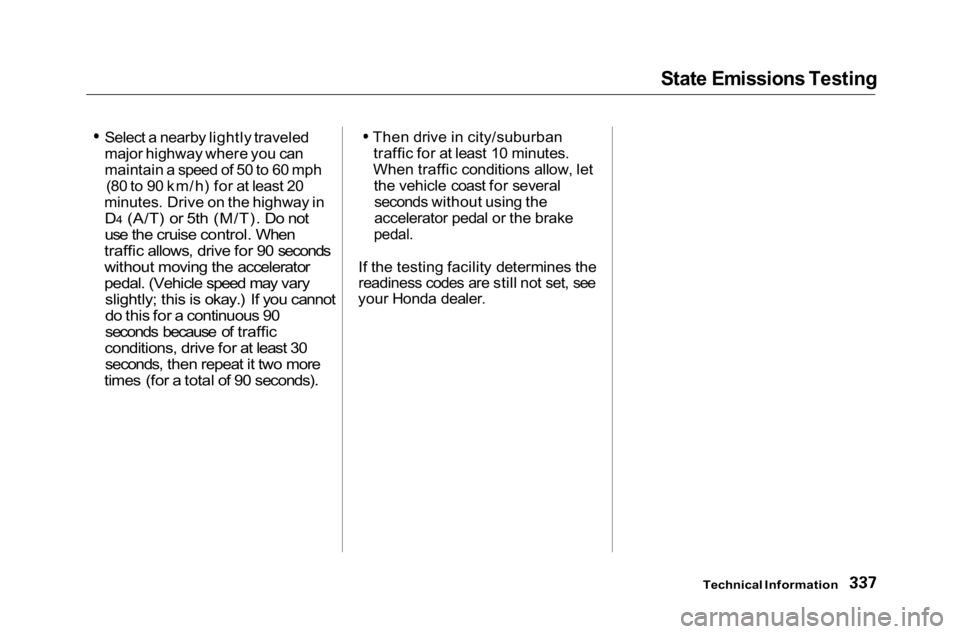
State Emissions Testing
Select a nearby lightly traveled
major highway where you can
maintain a speed of 50 to 60 mph (80 to 90 km/h) for at least 20
minutes. Drive on the highway in
D4 (A/T) or 5th (M/T). Do not
use the cruise control. When
traffic allows, drive for 90 seconds
without moving the accelerator
pedal. (Vehicle speed may vary slightly; this is okay.) If you cannot
do this for a continuous 90
seconds because of traffic
conditions, drive for at least 30 seconds, then repeat it two more
times (for a total of 90 seconds).
Then drive in city/suburban
traffic for at least 10 minutes.
When traffic conditions allow, let the vehicle coast for severalseconds without using the
accelerator pedal or the brake
pedal.
If the testing facility determines the
readiness codes are still not set, see
your Honda dealer.
Technical Information